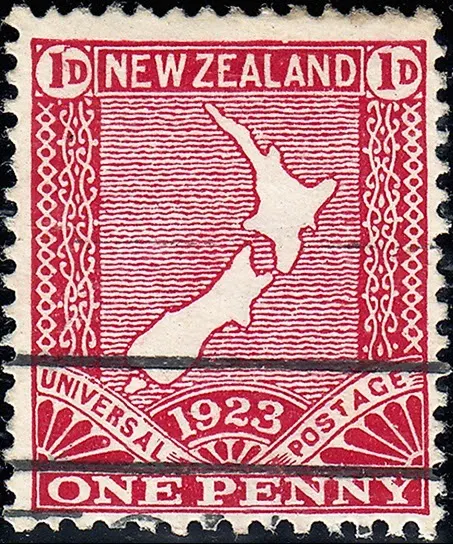 In 1923 the New Zealand Government decided that it was time to restore universal penny postage following its suspension in 1915. The map stamp was issued to commemorate this. The suggestion that the stamp design depict a map of New Zealand was made by Mr R F Joyce.
In 1923 the New Zealand Government decided that it was time to restore universal penny postage following its suspension in 1915. The map stamp was issued to commemorate this. The suggestion that the stamp design depict a map of New Zealand was made by Mr R F Joyce. Mr W R Bock was instructed to prepare a design and engrave a steel die. The plates were prepared and printed by the Government Printer, Wellington. The first printing was done using plates of 240 - 24 horizontal rows of 10. Later printings used a smaller plate of 120 - 10 horizontal rows of 12.
Strangely, however, the one penny dominion remained on sale and continued to be used, even after the map stamp was withdrawn from sale. The map stamp was the first and only stamp impression to appear pre-printed on postal stationery until the 1980s.
The dies for these early stamps were engraved using hand tools. It was very exacting work, a long and painfully slow process, done with great skill and precision. The die was then used to cast the segments of the printing plate. In this case the design and engraving work was done in New Zealand by an employee of the Government Printing office, a Mr W R Bock. Above is a large, blown-up image showing the fine detail of this design. The Map Stamps is considered a 'common stamp' that is often overlooked by collectors as being of little interest. I hope this post and the items included in it will help prove that idea to be wrong.
Damaged '9' Flaw.
The top loop in the '9' does not reach around to make a full circle.
Serif Flaw.
The '3' has a small extension pointing down at its lower end.
New Island Flaw.
An extra 'island' has appeared off the West Coast of the South Island. This looks to be damage to the fine lines making the ocean where they no longer got inked and touched the paper.
The Map Stamp was first issued on the 1st October, 1923. Above is a 'intended' First Day Cover sent from Christchurch to Wanganui on that date. It appears by the typing that this cover was intended to become a collected item.
Below is what looks like a commercial cover and it is what I would likely call an 'accidental' First Day Cover in that while it was sent on the first day of issue, it was not intended to be saved by a stamp collector.
Below is what looks like a commercial cover and it is what I would likely call an 'accidental' First Day Cover in that while it was sent on the first day of issue, it was not intended to be saved by a stamp collector.
An ordinary cover, a good example of the type of letter this stamp was intended for, using the newly introduced One Penny Postage. It was sent from Tokomaru Bay to Auckland on 11-12-1923.
Another standard letter but what is interesting about this one is the address. Rather than being given an address it was addressed via the carrier in Utiku. It appears the sender must have been known that the carrier would know who Mr Gibbs was. The letter was sent on the 17th of November, 1923. Wellington, being a larger city, used machine cancellations as can be seen running across this cover. Compare this with the hand cancel used on the cover above.
Now this cover looks an interesting mess. A 1d Postal Stationary Envelope was used but since it was going to France, the postage had to be up-rated using 2 1d Map Stamps and a half penny George V definitive. Upon reaching France, the cover then need to be redirected to a second address. The result is this very interesting cover.
Finally we have a 1d Map Stamp on a newspaper. Sounds simple enough, doesn't it? But this one is different, I've never seen one like it before. In other posts on this blog we have seen 'wrappers' that wrap round the newspaper and carries the address and postage stamp but in this case the stamp has been attached directly to the newspaper. Notice the address, written in red, is on the actual newspaper above the title. The newspaper is the Wanganui Herald, dated 12th Oct, 1924, which is also the date posted.










A nice post Mary.
ReplyDeleteI really liked that newspaper too.
Allan
Allan, how come you are commenting on your own blog?
DeleteAndy
Hi Andy,
DeleteYes it is Allan's blog but now he no longer does all the writing. I live an hour or so away from him so we don't get to talk much. He could have told me via email or yahoo but chose to comment here. Personally I am pleased that he did.
Mary
We appreciate your engagement with our content. To ensure a respectful and constructive community, please take note of the following:
- No Spam, Please: We do not tolerate spammy or promotional comments. Any such comments will be promptly removed.
- Moderation in Place: All comments are moderated to maintain a positive and inclusive environment. Please be patient, as it may take a little time for your comment to appear.
- Sign In with Google: To comment, please sign in using your Google account. This helps us maintain the integrity of our community and allows for better interaction.